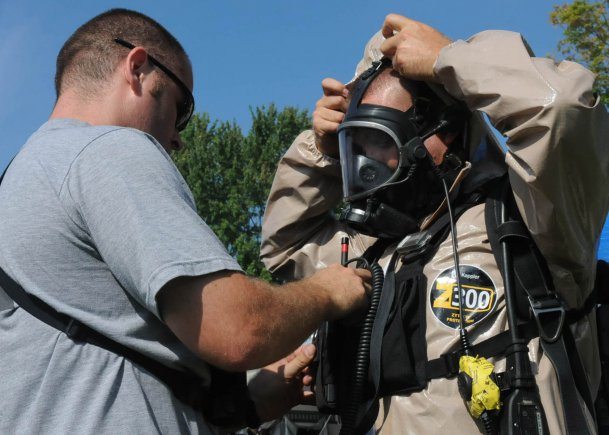It is not a scene one would wish to envision: an explosion in an American town, with the emergency response broadcast blaring a message of caution over loud speakers to concerned citizens affected by the blast. Burning buildings, clothes scattered in every direction, debris blocking once passable roadways, all are merely a small portion of a nightmare scenario.
During the field training exercise Vibrant Response 13-2, or VR 13-2, which runs Aug. 10-17, at the Muscatatuck Urban Training Center, or MUTC, civil Support teams train for the unexpected.
“The venues at MUTC, along with ability to use multiple smoke and flame effects, enhance the training and make it as real as it gets,” said Paul Condon, joint exercise planner, U.S. Army North (Fifth Army).
About 5,700 service members and civilians from the local, state and federal agencies flooded in to the MUTC and Camp Atterbury training areas to train on responding to a catastrophic domestic incident. VR 13-2, a major field training exercise conducted by U.S. Northern Command and led by U.S. Army North, is designed to help all components respond to disasters in a timely manner as they provide assistance to the American people.
The MUTC is a 1,000-acre urban training site near Camp Atterbury, Ind., that specializes
in real-world training scenarios. The training center is designed to add realism by simulating an actual American city in turmoil.
“The environment replicates an actual American town,” said Jay Norris, an observer controller/trainer division chief with Army North, who hails from Edinburg, Miss. “It has all the facilities of a typical small town, and that is the type of environment we’ll be operating in after a disaster strikes. The scenario is set in an American city where there has been a nuclear detonation, and these units are responding to that disaster.”
“This (the MUTC) looks like the very first episode of the TV series ‘The Walking Dead’ with all of the signs hanging, fires blazing and the appearance of absolute desertion,” said Sgt. Nicholas Erridge, a chemical, biological, radiological and nuclear, or CBRN, specialist from Portage, Ohio. He serves with the 51st Civil Support Team, or CST, Michigan National Guard, Joint Force Headquarters, out of Battle Creek, Mich. “This is a unique, realistic training environment.”
Taking advantage of the unique training environment are the CST units, which have specific missions they train for in order to prepare them for a real-world, American catastrophe.
“The mission for our unit, during the training, is to assist the first responders by providing route reconnaissance as well as setting up decontamination sites; we would handle the CBRN incidents,” explained Erridge.
The CST’s primary mission is to support the incident commander as well as those first responders (local, state and federal) by establishing safe areas through route reconnaissance and determining where there are potential radiological and chemical hazards, explained Maj. Ronald Crane, commander of the 53rd Civil Support Team, Indiana National Guard, Joint Force Headquarters Indiana, from Indianapolis.
“The civilian leadership is a critical part of our mission,” said Crane. “In fact, they are whom we are designed to work for. We work for the incident commander, so our ability to train with them is absolutely important to understanding of our roles.”
Role players helped provide a more realistic scenario by calling for assistance.
“While on recon mission, we ensure the citizens get the correct information on sheltering in place and know that help is on the way,” Crane said.
The civilian role players help provide a realistic feel to the training conducted at the center.
“Most of the time with military training exercises, we encounter dummies or we would have training aids to simulate the displaced citizens,” said Erridge, “but there is an added value when people play the role, realistic training.”
The psychological effects of seeing an actual person, as opposed to training aids, adds a level of difficultly appreciated on all levels of training.
“I believe, this is the closest that we can get to a ‘real-life’ mission, having civilian role players gives us a better opportunity to ‘train as we would fight,'” said Erridge.
The training at MUTC provides an opportunity to enhance unity and cohesion for personnel, who have never worked together before.
“My unit is supported by the 51st CST, a National Guard unit from Michigan,” said Staff Sgt. Dan’l Stebbins, a human resource specialist, who operates as a chemical, biological, radiological and nuclear specialist. Stebbins, who hails from Indianapolis, serves with the 53rd Civil Support Team, Indiana National Guard, Joint Force Headquarters Indiana.
“Having the Michigan CST here helps build our team and enforce stronger bonds between both units,” said Stebbins. “Right now, we have a very unique situation for the civil support teams; we have a combined footprint, meaning the Indiana CST is working in conjunction with the Michigan CST to establish a base of operation.”
Even working in a joint environment adds to the training conducted at the MUTC.
“It is a little easier when working with strictly Army personnel because they understand the terminology, but working together as a joint workforce brings an added value to the training,” Erridge said.
The MUTC focuses on providing realistic scenarios to train personnel for “real-world” situations.
“Muscatatuck provides an opportunity not just for the trainees, but also the trainers,” Crane said. “It leads the way for other training sites to come up with good training through complexity and realistic environments.”
Those participating in the exercise said the training opportunity is one they won’t soon forget.
“This is my first Vibrant Response training,” concluded Erridge. “It has been an awesome and memorable training experience.”










